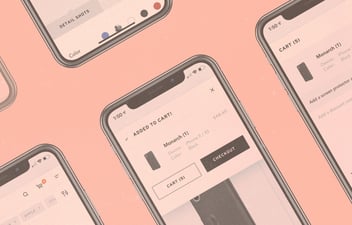In a market brimming with savvy consumers, user experience (UX) is a necessity. Exceptionally successful companies take all user touch points into consideration when developing cutting-edge products and digital experiences.
However, even the most conscientious of UX design can’t be all things to all users. In an effort to solve every problem for every user, products can be stretched too thin and offer little value to anyone.
That’s where UX strategy comes into play.
What is User Experience (UX) Strategy?
Simply put, UX strategy is a detailed plan to align the user experience and brand with the organization’s objectives and goals. Effective UX strategy brings the organization’s vision for the customer experience to life, all within the framework of the long-term strategy for the brand.
It is more about how and why your customers behave in certain ways, rather than specific features that need to be added, to create an overview of ideas to be implemented across platforms. UX strategies optimize the ways that customers interact with your company, strengthen your brand’s image, and increase conversions.
UX strategy has four vital components:
Business Strategy
Business strategy formulates and implements the major goals, initiatives, and objectives. Though UX is all about the user, it all circles back to the brand. Business strategy has a direct influence on UX strategy and the organization’s understanding of the market and competition.
Specific business goals and objectives should be incorporated into UX strategy as guidelines and success metrics. Otherwise, UX teams approach UX design based on best practices and competitive benchmarks, rather than with the intent of supporting business goals. Well-defined
UX strategy aligns the business strategy with the user and the technology to deliver exceptional products.
Value Innovation
features with the intent of competitive edge and lower costs. Ideally, value innovation creates new demand and influences the market enough to keep the organization at the top. This can be in the form of sustaining innovation or disruptive innovation. Sustaining innovation is mostly found in mature organizations that innovate with small improvements to well-established problems among the user base.
For example, cars solved the problem of efficient transportation over a century ago, but automakers offer continuous improvements to the experience with performance enhancements, advanced safety features, and upgraded entertainment technology.
Conversely, disruptive innovation is about disrupting the existing market’s status quo. Organizations tend to innovate faster than customer needs evolve, creating products that are too expensive, sophisticated, or complicated for their target customers. As a result, the most innovative of products sit at the highest tier of the market – with the highest prices.
When this occurs, organizations are vulnerable to disruptive innovations that enter at the bottom of the market. Now, an entirely new group of customers have access to a product that was reserved for the wealthier and more sophisticated customers. Examples of disruptors include personal computers ousting mainframes and cell phones replacing traditional landlines.
User and Competitive Research
Product development is expensive. Because UX is all about the user, organizations can waste tons of money on product development that doesn’t offer anything to the ideal user. Validated user research offers insight into product performance among target users to inform design and development decisions.
User research can be conducted in a multitude of ways, including tree testing, usability testing, interviews, and card sorting, but it should always happen early and continuously. Prototyping and testing is an easy way to get insights from the target users, find out if the product is viable, and map out the rest of the development process.
Competitive research complements user research by providing an overview of the market and product landscape. By considering current pricing, market trends, and direct competitors, organizations can understand the opportunities and challenges and how the product stacks against the competition.
Where To Start With User Research
User research is at the heart of every good UX strategy. The more you know about your users and your current user experience, the better you will be able to serve their needs, understand their behavior, and accomplish your business goals. It can be difficult to decide where to start with your user research, so it may be helpful to create categories of users, which can also help you decide how to best implement different design elements.
Primary stakeholders
It’s easy to find the primary stakeholders in the company you’re creating a UX strategy for - they’re usually the ones paying you. Primary stakeholders are people who are financially vested in the success of the business, such as the CEO or CTO, and are a wealth of information for how the business could improve.
Primary stakeholders probably have several specific concerns about the user experience they want to address, but you should also ask them about what they think is working well for both their business and their customers. This allows you to quickly identify existing ideas that need to be incorporated into the final UX strategy.
Since primary stakeholders have a vested interest in the financial success of the company, when you are creating your UX strategy it is good to mention how the ideas outlined will increase the brand’s financial success.
Secondary stakeholders
Secondary stakeholders also have an intimate understanding of the brand, but are not directly linked to the company’s financials. People like development leads, marketing managers, and visual designers are excellent resources for discovering detailed information that relate to their specific role.
It may be helpful to get opinions and suggestions from secondary stakeholders both individually and as a group, so that you can get detailed feedback centered around each person’s specialty, before bringing everyone together to talk about how changes in each area would interact with and affect the others. For example, if the visual designers thought the aesthetics of the website should be updated, the marketing managers may feel that certain aspects could have a negative impact on ads that are performing well.
Current users
If you are working on a UX strategy for a service or product that already exists, you should (hopefully) be able to find users who are already passionate about it. Try to find a handful of people who are active users to conduct short interviews with. Usually, current users are happy to answer a few questions, but tend to talk about how they feel, rather than specific behavior. You should make a list of specific questions ahead of time, so that you can direct the conversation to get the information you need.
It’s helpful to understand current users' behavior and background so that you can better address their wants and needs. Finding out their preferences and reasoning strengthens your UX strategy and leads to a more impactful design. You should ask if you can follow up with all of the users you interview, so that you are able to get their feedback on future changes and improvements and see if you addressed the needs and concerns they presented in the interview.
Beta testers
UX strategies for new companies and products may rely on the feedback of beta testers. Beta testers are people who are using the prototype of the product, website or app, before the final version is released. Beta testers may have more complaints than typical users, because prototypes of products, platforms and websites tend to be unfinished, leading to increased issues. Beta testers often still have valuable feedback, even if many of the problems they report stem from using a prototype. Make note of their overall impressions and feelings about the brand, so that you can make improvements to your brand’s personality, messaging and aesthetics.
Subject matter experts
If you are working on a UX strategy for a company in a technical niche, such as law, financial services, or a new technology, you will want to glean knowledge from subject matter experts. It is incredibly important to consult with experts in technical fields, rather than make assumptions or rely solely on stakeholders and users. Subject matter experts will ensure that you don’t lose credibility, and can give you a better idea of what your audience is looking for, as well as what may elicit positive or negative reactions.
It is not necessary to rely on experts for every aspect of your UX strategy or design, but they are a wonderful resource during the research process, and can be consulted when changes are made, to check for errors and accuracy.
Users of competing products
The best way to find out about the users of competing products is to see what they are posting online. This information may come from reviews, posts on social media or forums, or even comments that were made on public posts or advertisements. Information about competitors strengths and weaknesses, as well as the customer’s needs are invaluable when putting together a UX strategy.
Industry Data
Industry data gives you an unbiased, factual view of how consumers behave in your industry. If your company has an existing website, that’s a great place to gather information on how customers interact with your brand. You can usually gain a better understanding of how people are reacting to different features and where there are problems that could be solved, which gives you insight into how to create a better experience for users and increase conversions and performance.
Here are some questions to ask during the research process:
- Who’s the target user?
- Who are the biggest competitors and what do they have to offer?
- What are existing solutions doing right and how can they improve?
- What are the goals and objectives?
- What is the budget?
- What is the organization’s mission?
- Is there an opportunity for a unique value proposition?
Here are some questions to ask users for more detailed insights:
- What would improve our product’s experience?
- What do you like about the product? What could be better?
- What do you like about the current products on the market? What could be better?
- What features are the most/least important to you?
- How likely are you to recommend our product to a friend or family member? Why?
- How did you find our product?
These answers will give you deeper insights into the market, your users, and how to approach your product design.
-
UX Design
Up to this point, UX strategy is about goals and planning. After aligning the organization’s goals with an innovative edge and extensive user testing, it’s time for the build. UX design is the last stage in the process, but the one that delivers on all that planning.
The design team has a process to deliver meaningful, seamless, and relevant experiences to users. Effective UX design revolves around product innovation, product integration, branding, design principles, functionality, and usability. Stellar UX design will hit on all these principles.
Why create a UX strategy?
Your UX strategy is (in my completely unbiased opinion as a UX designer) the most important step in creating an innovative and memorable user experience. When the time is taken to construct a well-researched UX strategy, it creates clarity and consistency when building a user experience for your brand. UX strategies are a way to give your brand cohesiveness, while also prioritizing customer wants and needs. UX strategies are also helpful to have as your business grows, giving all team members a reference for how to carve out a space on new platforms, create new marketing campaigns, and develop new products.
Where are we now?
To map how to get somewhere, you have to know where you are. UX strategies start by acknowledging where you are as a brand, including your strengths and weaknesses. Some ways to better understand where you stand, you can utilize:
-
Product metrics - Quantitative data will always be a great asset, since it allows you to measure improvement over time. Your product metrics not only paint a picture of the current state of your business, but also allow you to track your progression after executing changes.
-
User research - User research is useful to find out how your brand is perceived, and where improvements are needed. It also is used to discover what is working well and could be highlighted as an asset to the brand. User research can include interviews and interactions with customers, or metrics about how and why users behave the way that they do.
-
Competitive research - It’s important to know what the competition is doing and how they are performing, so that you have a deeper understanding of where you stand in the industry. You can also identify weaknesses that the competition isn’t addressing, and what they are doing well, making it easier to construct a more effective UX strategy. If you can set your company apart by fulfilling a need that has gone unaddressed, you will increase your user base while bolstering your brand’s reputation and increasing visibility.
Where are we going?
Dig deep when coming up with your goals for the future. While your UX strategy can (and should) be updated regularly, it is important to keep your long term aspirations in mind so that the correct framework is built to accomplish those objectives. Short term goals can be included, and substructures created, if needed. You shouldn’t focus too much on a single platform, but instead decide what you want to achieve as a brand. Image is also an important aspect of determining where you want your brand to go, since it will be difficult to change once established.
How do we get there?
Many companies find themselves adding concrete steps to their UX strategies, but we find that it’s best to take a more theoretical approach. Ideas about what you should do (like improve the functionality of your mobile platform), are more important than how you should do it (such as adding specific features or buttons). Your UX strategy should be written in a way that allows you to refer back to it in the future, so that you can continue to implement new technology and tools as they become available.
Why UX Strategy is Essential
While it would be nice to expedite products to market, that’s not conducive to successful, innovative products. The reality is that product development isn’t fast or cheap, but including a UX strategy at the earliest stages of a project can save money, time, and resources in developing products that consumers actually want.
Here are a few benefits of UX strategy:
Data-Driven Decisions
New products are often an exercise in uncertainty. Organizations may not be sure of the target user or the problems that need to be solved. With user research, organizations can determine if they’re developing the right product and the best features.
Users offer plenty of valuable insight into what problems they have and how existing solutions solve, or fail to solve, them, providing a starting point for developing products with valuable solutions and a competitive edge.
In addition, customers tend to stick with products they know and like, even if they don’t solve every problem. Because of this, new products have to offer a value proposition that can convert users from what they know and trust.
Another common obstacle for product development is offering products that are competing with effective, existing solutions or products that attempt to solve problems that users don’t have. User research offers insights into current user problems, existing solutions, and gaps that can be filled.
Reduced Risk
Basing time, money, and energy output on digital product design without any user guidance is a recipe for disaster. UX strategy lowers the risk in product development by implementing research, planning, testing, and validation phases to ensure that resources are allocated efficiently.
When user research indicates that a product or feature is going in the wrong direction, the organization has the agility to redirect the focus without significantly impacting the time and budget.
Feature Priority
As mentioned, no product offers a solution for all problems for all users. UX strategy helps organizations prioritize problems and their solutions to provide the maximum benefit to users. Without this guidance, product development may attempt to solve every possible problem.
With the minimum viable product (MVP), feature priority is especially important in UX. The MVP is typically the first completed version of the product with a limited set of features that satisfy the user’s needs. Many organizations use the MVP to get a product to market quickly, so it’s that much more important to make an impact on the market.
Creating the UX Strategy
Once you have completed your research, the next step is to figure out the best way to apply all the data you collected, and condense it down into a single page, that will be the beacon of inspiration that guides your entire project. Easy enough, right? Well, maybe not. Let’s look at the best ways to process the information you gathered to strengthen your UX strategy.
How Create a UX Strategy Transforms the Customer Journey
One of the major challenges in the current market is for an organization to position themselves or their products ahead of competitors. Spectacular user experience enhances customer engagement, loyalty, and conversion with streamlined and valuable experiences at every touchpoint. This can’t happen without a solid UX strategy that considers all aspects of the product’s branding, usability, design, and functionality.
UX designers consider the why, what, and how of product use. Without a UX strategy that includes insights from user and competitive research, value innovation, and the organization’s goals, the designer is unable to create a product that exceeds expectations.
For the purposes of UX strategy, customer journey maps are research-based tools that show the intersection of the user and the organization over time and across all channels. This tool is useful for design teams to see how the customer experience measures up to the customer expectations and find areas for improvement.
*Customer journey maps typically consist of:
- A timescale for the journey period
- Scenarios for the context and sequence of events
- Touchpoints for where and how customers interact
- The channels in which customers perform actions
Customer Journey Maps
The customer journey includes all the touchpoints a customer has when interacting with the organization and the brand for a holistic view of the customer experience. A customer journey map provides a visual journey to showcase the customer’s perspective.
A customer’s interaction with a brand can’t be narrowed down to a single webpage or application. You need to consider all of the ways your customers will interact with your brand, taking a holistic approach to maintain consistency and fluidity between platforms. Your UX strategy should follow your user’s journey from their first interaction with your brand, so that you are able to find any snags that may be causing delays or conversion issues. A common mistake businesses make is trying to design a UX strategy for a single platform. Since a user experience is rarely confined to just one website or application, this leads to many areas that remain completely unaddressed.
Designing Touchpoints
A touchpoint is where a user comes into contact with your brand or product. When you are drafting a UX strategy, you should make a list of touchpoints for your company. Online touchpoints may include:
- Websites
- Mobile applications
- Social media platforms
- Online advertisements
There are also non-digital touchpoints, which are arguably more important, since they are difficult to update and manipulate. These include things like:
-
Brick and mortar locations
-
Phone interactions
-
Packaging
-
Physical products
-
Offline advertisements
You can use your list to understand how a user moves from one touchpoint to another, and which touchpoints interact with each other. This will help you improve your user experience, and create a brand ecosystem.
Building Ecosystems
Building a brand ecosystem is a way to bring all of your touchpoints together as a cohesive unit. This allows you to take control of the entire user experience, rather than a single aspect of it. Building an ecosystem strengthens your brand’s image and reputation, and blurs the lines between platforms and touchpoints, which leads to increased brand loyalty and higher conversions.
When you use your UX strategy as a guideline for your brand’s entire ecosystem, you may notice that you increase your following, since doing so improves brand awareness and visibility. You will also be able to customize your user experience so that the user journey becomes more reflective of your company’s overall message, tone, and aesthetics.
How UX Strategies Help Your Brand Adapt
UX strategies are extremely helpful as technology continues to advance rapidly, requiring brands to be consistent across multiple platforms, while being capable of adapting to change. By evaluating the user experience in all capacities, and not just fulfilling customer needs, but also crafting a unique message, image, and personality for your brand, UX strategies help your business remain flexible while keeping a uniform image.
Deliver the Best Products Possible with UX Strategy
Through all these dimensions and factors, organizations can understand the customer experience and how it develops over time. This is the ideal opportunity to identify existing and potential problems and improve the design for better user experience.
In a rapidly evolving business market, UX strategies allow organizations to create and develop products tailored to the users’ needs and the brand’s goals. When you consider user experience from all angles, your organization can ensure that your products satisfy your business needs while providing stellar user experience for loyal, engaged customers.
Partnering with a customer experience agency such as Vincit can be instrumental in the development and implementation of an effective UX strategy. With a demonstrated history of delivering successful projects, Vincit has the expertise to help design and implement a winning UX strategy that improves customer satisfaction, increases brand loyalty, and drives business growth.



